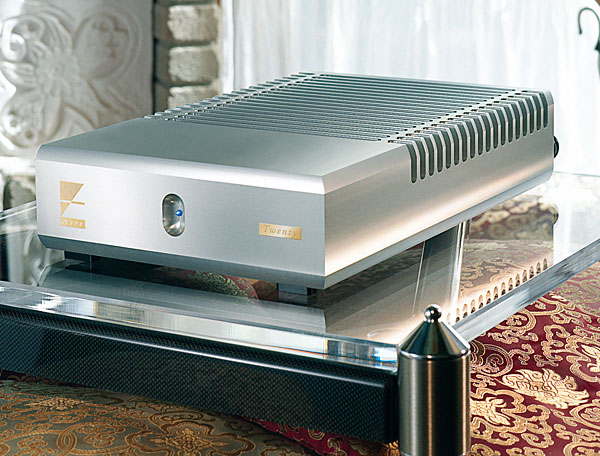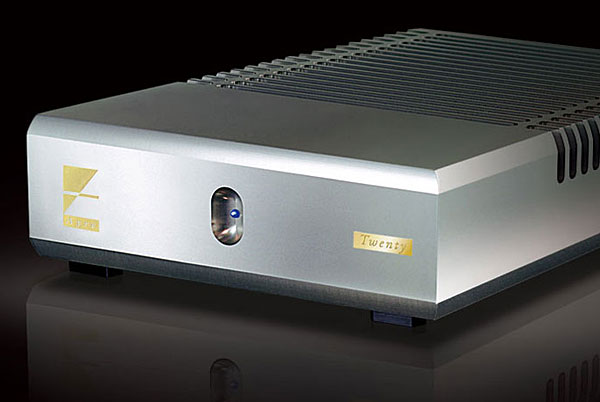| Columns Retired Columns & Blogs |
The -112dBW unweighted residue noise is spectacular.
However, in figure 4, the 120Hz hum noise component is only -100dB below the 2.83V signal. Is it something going on?
If I'm going to talk bass guitarists, I mustn't forget the late Jaco Pastorius. When he launches "Cotton Avenue," from Joni Mitchell's Don Juan's Reckless Daughter (AIFF file, 24-bit/192kHz needle drop from LP, Asylum K63003), his detuned low F and C were so well formed and so palpable that they rolled from the speakers and across the floor toward me!

This palpability made itself felt even with historic recordings, such as the Grateful Dead's Live Dead, from 1969 (ALAC files ripped from CD, Warner Bros. 1830-2), with its superlative sequence of "Dark Star," "Saint Stephen," and "The Eleven." And it's not coincidental that I'd been listening to Sly and the Family Stone's Live at the Fillmore East: October 4th & 5th, 1968 (4 CDs, Epic 88843023712) through the Ayre-founded system when I recommended to music editor Robert Baird that we make this almost-half-century-old set this issue's "Recording of the Month." In contrast to the Dead's Phil Lesh, who often plays around the beat, adding counterpoint to the drum lines, the kick drum and Fender Jazz Bass of the Family Stone's Gregg Errico and Larry Graham respectively march in lockstep through these high-energy concerts, together in time but distinguished in tonality by the Ayre amps. Lesh and Graham are polar opposites in their approaches to the music they play, but with all of the speakers I used with the Ayres during the review period, both bassists were equally well served, the MX-R Twenty combining power with sweetness.
Classical double bassists were served equally well by the Ayre MX-R Twenty. I used to love the music of Sibelius, but hadn't played any for too long a time. I reached for Symphony 5, with Herbert von Karajan conducting the Berlin Philharmonic (ALAC files ripped from CD, EMI Studio CDM 7 69244 2). To underpin the work's ambiguous tonality, halfway through the finale Sibelius has the double basses, normally used by composers to provide a solid foundation to the harmony taking place above, playing divisi two notes that "fight," E-flat and F. With regular systems, the listener is aware that there is something "sour" in the apparently muddy sound of the basses at this point; a look at the score reveals why. With high-quality speakers driven by the MX-R Twentys, the score is unnecessary—you hear the discord as Sibelius intended: two low notes almost identical in frequency, but far enough apart in pitch to be easily distinguished, and understood as deliberately intended by the composer.
Comparisons
The Pass Labs XA60.5s have been my go-to amplifiers since I reviewed them for the January 2014 issue, primarily because of the spatial magic they work. The soundstage thrown by the Ayre MX-R Twentys was more forward than that produced by the Passes, with foreground objects lying more in the plane of the speakers. In that aspect of their sound, the MX-R Twentys reminded me of Lamm Industries' M1.2 References, whose sound has a similar glow. But the MX-R Twenty's lows were fuller than the Lamm's, and, especially, better controlled and more weighty than the Pass's.
Of the amplifiers I had to hand, the champ at controlling woofers was the MBL Corona C15. With levels matched to within 0.1dB, the MBL's reproduction of my solo Fender Bass tracks on Editor's Choice (ALAC files ripped from CD) sounded tighter but more ethereal than the Ayre's. We're back to that palpability thing. Both amplifiers gave an almost perfect combination of leading-edge definition and tonal weight, but the Ayres made my Fender sound—and feel—more as if it were in my hands.
Compared with the Bricasti M28 monoblocks—which, at $30,000/pair, compete almost head-on with the Ayres in price—the MX-R Twentys did lack ultimate low-frequency extension. As I write in my Follow-Up review elsewhere in this issue, the bass guitar and kick drum in "My Rival," from Steely Dan's Gaucho (24/96 ALAC file transcoded from FLAC, MCA/HDtracks B0000868-36), sounded weightier through the Bricastis than through the Ayres. But the M28 has a more polite upper-frequency balance than the MX-R Twenty.

Conclusions
For an amplifier at any price to be able to do everything superlatively well is a big ask. But as I finish writing these words, I'm listening to Bill Frisell's rhapsodic traversal of "Shenandoah," from his East/West (ALAC files ripped from CD, Elektra Nonesuch), with GamuT RS7 speakers (review forthcoming) driven by the Ayre MX-R Twenty amplifiers. The jump factor of Kenny Wollesen's snare drum, the growling palpability of Viktor Krauss's double bass, the sense of space surrounding Frisell's stereo-processed guitar, the sheer musical communication—it's hard to envisage how another amplifier could do better than this.
But this performance comes at a price—the Twenty costs nearly 80% more than the original MX-R. Still, it's fair to say that two of the three amplifiers I've tried that get closest in overall sound quality to the Twenty, Lamm's M1.2 Reference and MBL's Corona C15, aren't that much less expensive—and the third, Bricasti's M28, costs slightly more.
All I can say is that if fortune has smiled sufficiently kindly on you that you can write a check for a pair of MX-R Twenty amplifiers without breaking a sweat, you should do so—and then invite me round for regular listens.

The -112dBW unweighted residue noise is spectacular.
However, in figure 4, the 120Hz hum noise component is only -100dB below the 2.83V signal. Is it something going on?

The -112dBW unweighted residue noise is spectacular.
One of the best I have measured.
However, in figure 4, the 120Hz hum noise component is only [100dB] below the 2.83V signal. Is it something going on?
The apparently anomalous behavior stems from the fact that I measure S/N ratio with the amplifier's input shorted. There is therefore no signal current being drawn from the power supply. But in my spectral analyses of the low-frequency noisefloor, I use a more realistic condition, which is with the amplifier delivering at minimum 1W into 8 ohms. In this condition, the AC transformer is being asked to deliver greater current, and the 120Hz and 240Hz spuriae appear. But at -100dB, these are still negligible.
John Atkinson
Editor, Stereophile

John:
You can't measure S/N with the inputs shorted otherwise where would you apply the signal? I believe what you meant to say is that you measured the amplifier noise floor with the inputs shorted. This makes more sense and is the correct way to do so.

You can't measure S/N with the inputs shorted otherwise where would you apply the signal? I believe what you meant to say is that you measured the amplifier noise floor with the inputs shorted.
The Signal/Noise Ratio is the measured level of the component's self-generated noise within a specified bandwidth referred to a specified level, in this case 2.83V into 8 ohms. The noise level is conventionally measured with the component's input shorted to ground.
The individual components of the noisefloor, examined in a separate measurement, are, of course, lower than the measured noise power used to calculate the S/N ratio, as the latter is the RMS sum of those components.
The poster's argument was that if spectral analysis showed that a supply component at 120Hz was present at -100dB ref. 2.83V, the unweighted RMS sum of the noisefloor components used to calculate the S/N ratio couldn't be less than 100dB.
John Atkinson
Editor, Stereophile

So the left/right channel inputs are shorted together and both fed a 2.83V mono signal? Sorry being dense as I'm still confused where you apply the 2.83V level signal to perform these measurements. Thanks...

So the left/right channel inputs are shorted together and both fed a 2.83V mono signal?
No, this has nothing to do with connecting the left and right inputs together. (And this is a mono amplifier, please note.) The 2.83V is the reference level at the amplifier's output. It is equivalent to a power of 1W into 8 ohms. (Strictly speaking, it should be 2.82843V, but 2.83V is close enough for this kind of measurement.)
Sorry being dense as I'm still confused where you apply the 2.83V level signal to perform these measurements.
This the procedure I use to measure S/N ratio:
Feed the amplifier an input signal at 1kHz so that the output level is exactly 2.83V RMS into 8 ohms.
Set this as the analyzer's reference level.
Turn off the signal generator. With the Audio Precision system I use, this connects both the hot and cold phases of its balanced output to ground.
Read on the analyzer's screen what the level now is, in dB referred to the previous level of 2.83V. This is the S/N ratio for whatever analyzer bandwidth I have chosen. (The Audio Precision gives me the choice of flat response from <10Hz to >500kHz or from 22Hz to 22kHz, plus the option of applying a weighting filter, like CCIR or A-weighting.)
I hope this explanation clears thing up.
John Atkinson
Editor, Stereophile

OK...thanks. That makes sense now. I wasn't aware that you ground the AP analyzer outputs after determining the reference AP voltage needed to produce a 1W amplifier output into an 8 ohm load. So the AP takes that reference signal level and divides it by the measured output noise when the amps inputs are grounded to calculate the S/N ratio. Is that about right?

So the AP takes that reference signal level and divides it by the measured output noise when the amps inputs are grounded to calculate the S/N ratio. Is that about right?
That's correct. The AP can display the noise level in dB vs an arbitrary reference, as in this case, as dBm, dBV, and other decibel-related ratios, or as the absolute level in milli- or microvolts.
John Atkinson
Editor, Stereophile